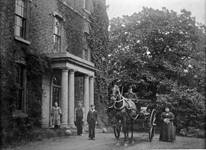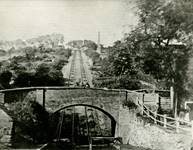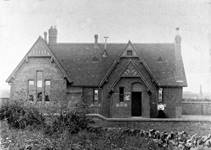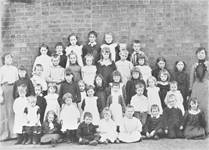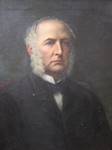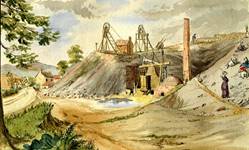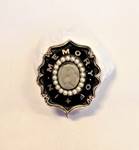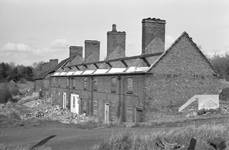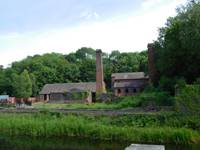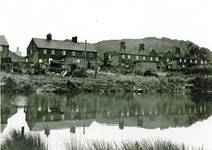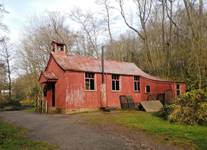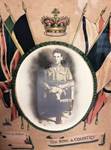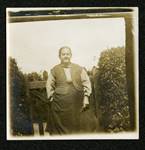People of Blists Hill
The history of Blists Hill stretches back to the late 18th century. Mining, iron production and brick and tile making dominated the site throughout the Victorian era but have since disappeared, as has the row of terraced cottages that once housed some of the workers. In their place stands Blists Hill Victorian Town, a reconstructed working class town which includes buildings that have been moved brick-by-brick from the local area by the museum. Over the centuries, hundreds of people have lived or worked on this site, or in the buildings that have been moved here. These are the stories of a just a few of those people.
The ‘Shroppie’ - Emma Evans
In the 1860s and 1870s a young woman called Emma Evans lived at Blists Hill with her father, grandfather and sister. Both Emma and her sister had to start working at local mines as pit bank girls, also known as ‘shroppies’, in their early teens. They were paid to pick pieces of ironstone out of seams of clay that had been deposited on the pit bank by miners. Emma would have been part of a gang of girls who put the ironstone into containers, which they then carried on their heads to ironstone heaps. From there it was taken to blast furnaces where it would be used to produce pig iron.
Photograph of Emma later in life, unknown date
It was tough work and they were expected to be on the pit bank from 6am until 4pm in all weathers. They were paid between 8d and 1s for a day’s work (about £3 today) which was a quarter of an unskilled miner’s wage. If they could afford it, most women gave up work on the pit bank by their mid-twenties or when they got married. This is what Emma did, although she carried on working as a domestic servant until she married in 1881.
An ironstone pit in Madeley Wood, 1847. Painted by Warrington Smyth (1817 – 1890), a mining geologist, this is the earliest known illustration of women working at a Shropshire mine
The Owners - The Anstice Family
The Anstice family played an important role in the life and prosperity of Madeley throughout the 19th century. The family’s association with Blists Hill began in the late 18th century when William Anstice moved to the area and began working with his uncle and distant cousin William Reynolds, the owner of the Madeley Wood Company. They worked together until Reynolds death in 1803 after which William Anstice took full ownership of the Madeley Wood Company. He went on to establish the blast furnaces and brickworks at Blists Hill as well as several more mines in the Madeley area, and at its peak the company employed about one thousand people. When William died in 1850, his son John took ownership of the company.
Portrait of John Anstice, unknown date
As well as being industrialists, the Anstice family were important local philanthropists. They were responsible for building a school and mission room at The Lloyds in 1852 and were known to pay the funeral expenses of their employees who died whilst at work. John Anstice was well respected by his workers, and following his death in 1867 a memorial fund was set up. This fund, along with money donated by the Anstice family, paid for the building of the Anstice Memorial Hall in Madeley. The Hall was opened in 1870 and became a place for entertainment, education and socialising for local people.
Following John’s death, his sons John and Richard, along with his brother William, took over the management of the company. William died in 1881 and his nephews continued the business until 1918, when they sold the company.
Photograph taken outside Madeley Wood Hall, the home of the Anstice Family, in 1912
The School Mistress – Margaret McCallum
The school at Blists Hill was moved to the site brick-by-brick from its original location in Stirchley where it had been built in 1881. One of the many headteachers this school had over the years was Margaret McCallum. Margaret was born in Coleraine, Northern Ireland in 1875. Her father was a shopkeeper and earned enough money to allow her to continue her education past the age of 10, the minimum school leaving age in the 1880s. She became a pupil-teacher, a form of teacher-apprentice, at her local elementary school and trained there throughout her early teen years. She passed her Scholarship Examinations and went on to attend the Marlborough Street College, Dublin for further training, where she passed her exams with “special distinction”. At some point in the 1890s she moved to England and taught in a school in Bedfordshire before moving to Stirchley in February 1900. When she started she was teaching 93 pupils between the ages of three and 13 with just the help of two pupil-teachers (who Margaret also had to train). By all accounts she was a well-liked and respected teacher. However, her time at Stirchley was sadly cut short when she died of meningitis in May 1905 aged just 30 years old.
The teachers and pupils at Stirchley Board School, 1902. Unfortunately, we do not know which of the teachers was Margaret McCallum.
Stirchley Board School in the early 20th century
The Soldier – William Doody
William Doody was born William Palin in St George’s in 1885 and was the illegitimate son of Mary Ann Palin, a ‘general labouring woman’. When William was four years old his mother married John Doody who lived at Granville Buildings, Donnington, and it was there in 1896 that a new Mission Church was built which his family began attending.
By the age of 15, William was working at the local colliery, and did so until war broke out in 1914. He enlisted into the King’s Shropshire Light Infantry (KSLI) and landed in France in mid-January 1916. Shortly after, William experienced one of the most notable moments of his military career. During a battle near Ypres in April 1916, he was shot through the knee. However, William managed to crawl to the German trenches and helped to hold them with his fellow soldiers for 36 hours against two counter attacks.
Granville Buildings during their demolition in 1967
William Doody during the First World War.
William recovered and in September 1918 was fighting as part of the KSLI 10th Battalion somewhere between Longavesnes and Villers-Faucon in France. It was whilst fighting there that he was killed in action on the 7th September 1918. He was buried in France and a memorial plaque was erected in Granville Mission Church.
Nearly 60 years later, in 1977, the Mission Church was moved and re-opened at Blists Hill. The memorial plaque to William can still be seen there today.
Granville Mission Church now located at Blists Hill Victorian Town
The Laundress - The York Family
In the 1870s John and Caroline York and their young family moved into one of the houses which made up Blists Hill Row, a row of terraced houses that were at Blists Hill until their demolition in the 1970s. John began working as a labourer at the brick and tile works but sadly died in 1883 aged just 47, leaving his wife Caroline to care for their children alone. The oldest child still living at home, Ada, was working at the brick and tile works but her small wage could not support the entire family. Caroline applied to the Poor Law Guardians for financial help but they informed her that she would only receive money if she sent some of her children away to the Industrial School at Quatt. Caroline refused and began taking in washing from the Anstice ladies living at Madeley Wood Hall. Meanwhile two of her daughters, Emma and Martha, dropped out of school and started working with their sister at the brick and tile works. With all of their meagre earnings combined, Caroline managed to keep her family out of the workhouse.
Blists Hill Row being demolished in 1963
Blists Hill Brick and Tile Works where the girls of the York family worked in the late 19th century
The Engineer - Henry Williams
In 1788 the company who owned the Shropshire Canal launched a competition to find a new design to perfect incline planes in this area. Incline planes were used to raise and lower canal boats up and down hills when locks were not practical. There were already some in existence but the system they used had several issues. Henry Williams, an engineer, submitted a new design alongside the Shropshire Canal company’s surveyor, John Lowden. Henry and John were selected as winners of the competition and were awarded 50 guineas (about £4000 today). Their design was used for three incline planes on the Shropshire Canal, including the Hay Incline Plane at Blists Hill built in 1793.
The Hay Incline Plane in the late 19th century.
A Mourning Brooch in memory of Henry Williams (1753-1842) which belonged to his wife Martha.
Henry went on to become the Shropshire Canal company’s manager and principal engineer before becoming a manager of the Ketley ironworks in 1818. In 1803 he married Martha Clayton. Together they had 8 children and lived at Ketley Hall until Henry’s death in 1842. Martha had this brooch made following his death, which contains a lock of Henry’s hair in the centre.

